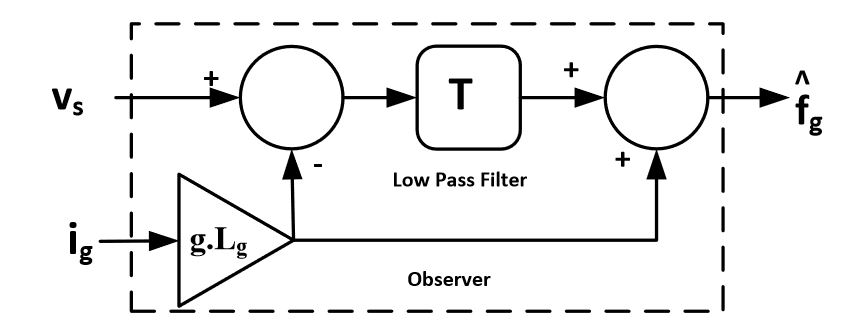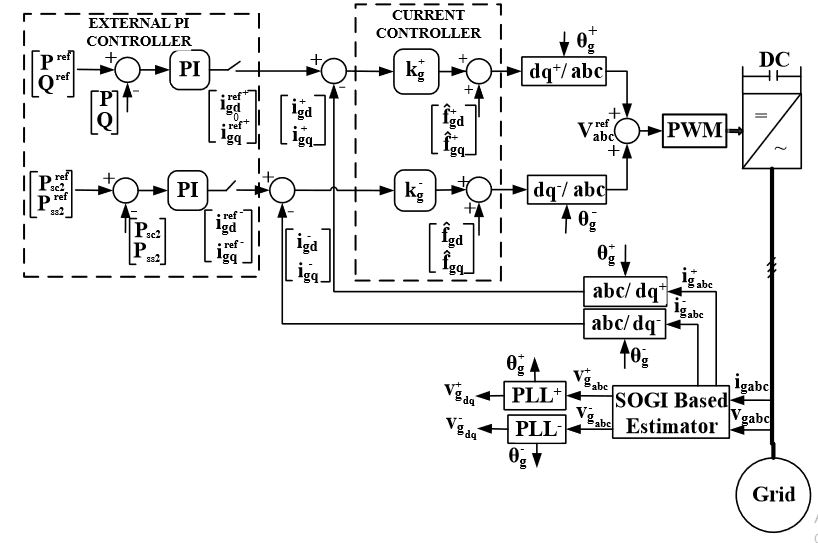ABSTRACT
This paper proposes a new approach on the novel current control strategy for grid-tied voltage-source inverters (VSIs) with circumstances of asymmetrical voltage conditions. A standard grid-connected inverter (GCI) allows the degree of freedom to integrate the renewable energy system to enhance the penetration of total utility power. However, restrictive grid codes require that renewable sources connected to the grid must support stability of the grid under grid faults.
Conventional synchronously rotating frame dq current controllers are insufficient under grid faults due to the low bandwidth of proportional-integral (PI) controllers. Hence, this work proposes a proportional current controller with a first-order low-pass filter disturbance observer (DOb). The proposed controller establishes independent control on positive, as well as negative, sequence current components under asymmetrical grid voltage conditions.
The approach is independent of parametric component values, as it estimates nonlinear feed-forward terms with the low-pass filter DOb. A numerical simulation model of the overall power system was implemented in a MATLAB/Simulink (2014B, MathWorks, Natick, MA, USA). Further, particular results show that double-frequency active power oscillations are suppressed by injecting appropriate negative-sequence currents. Moreover, a set of simulation results provided in the article matches the developed theoretical background for its feasibility.
DYNAMIC MODEL

Figure 3. Disturbance observer (DOb) block diagram
The proportional current controllers are sufficient to track the desired current requirements with accurately estimated disturbance terms. The block diagram in Figure 3 is used to estimate disturbance terms. An online Second Order Generalized Integrator (SOGI)-based symmetrical component estimation is achieved with the method given. PLL structures separately calculate the symmetrical voltage phase and angle. It is assumed that symmetrical component decomposition of the voltage and currents is perfectly estimated, and an accurate PLL voltage phase and angle estimation is achieved.

Figure 4. Proposed controller structure
The proposed scheme is depicted in Figure 4. If zero igd and igd references are chosen, injected currents towards the grid are sinusoidal; this supports power quality requirements. If a zero Psc2 – Pss2 reference selection is selected, double-frequency oscillating power components can be compensated for by injecting negative-sequence currents towards the grid. The proportional current controllers are sufficient to track the desired current requirements with accurately estimated disturbance terms.
SIMULATION RESULTS

Figure 5. Simulation circuit
Figure 5 depicts the simulation circuit implemented in MATLAB/Simulink using the SimPowerSystem tool. The GCI was connected to a transmission system, and all necessary parameters for the simulation are given in Table 1. Four different simulations were implemented to validate the proposed controller structure. The first simulation demonstrated the deteriorated current and power waveforms under unbalanced voltage conditions with the positive-sequence controller, without enabling the negative-sequence controller (Simulation A).

Figure 14. Simulation D results with the conventional PI controller
This problem is also stated, in that symmetrical decomposition methods degrade dynamic performance and may cause steady-state errors in PI controllers. It was shown in Simulation D that the aforementioned problem exists in constructed simulation platforms with kp = 20 and kı = 5 values. The dynamic performance seemed equivalent under a balanced operation; steady-state error plots under an unbalanced voltage operation are demonstrated in Figure 14.
CONCLUSIONS
The objective of this paper was to investigate a novel current controller that was based on a low-pass filter DOb, to provide a precise control of currents under unbalanced grid voltage conditions for a grid-tied inverter. The GCI was modeled in the symmetrical synchronous reference frames, and estimated disturbance parameters were fed to current controllers. P and Q were defined by using the instantaneous power theory, and double-frequency Pss2 and Psc2 pulsations were removed under a full propagation cycle.
PI and proposed DOb-based proportional current controllers were compared, and it was demonstrated that conventional PI controllers may cause steady-state errors under an asymmetrical grid voltage operation. Numerical simulation results also proved that the methods applied were able to compensate for the double-frequency power oscillations for the grid-tied inverter application, which means that the objective was achieved.
The proposed current controller seems to be a valid alternative solution for GCIs under unbalanced conditions. Hopefully, the results presented will form a basis for diagnosis methods regarding the control techniques of GCIs under unbalanced network conditions. Due to the fact that the study was limited to the simulation results, instead the effect of real components, more research is certainly needed.
Source: University of Johannesburg
Authors: Emre Ozsoy | Sanjeevikumar Padmanaban | Lucian Mihet-Popa | Viliam Fedak | Fiaz Ahmad | Rasool Akhtar | Asif Sabanovic
>> 200+ Matlab Projects for Control System for Final Year Students